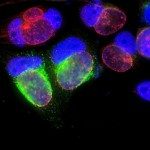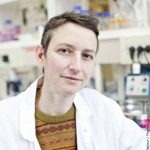Link to Pubmed [PMID] – 15316015
J. Biol. Chem. 2004 Nov;279(45):46896-906
The developmental cycle of Chlamydiaceae occurs in a membrane compartment called an inclusion. IncA is a member of a family of proteins synthesized and secreted onto the inclusion membrane by bacteria. IncA proteins from different species of Chlamydiaceae show little sequence similarity. We report that the biochemical properties of Chlamydia trachomatis and Chlamydia caviae are conserved. Both proteins self-associate to form multimers. When artificially expressed by the host cell, they localize to the endoplasmic reticulum. Strikingly, heterologous expression of IncA in the endoplasmic reticulum completely inhibits concomitant inclusion development. Using truncated forms of IncA from C. caviae, we show that expression of the C-terminal cytoplasmic domain of the protein at the surface of the endoplasmic reticulum is sufficient to disrupt the bacterial developmental cycle. On the other hand, development of a C. trachomatis strain that does not express IncA is not inhibited by artificial IncA expression, showing that the disruptive effect observed with the wild-type strain requires direct interactions between IncA molecules at the inclusion and on the endoplasmic reticulum. Finally, we modeled IncA tetramers in parallel four helix bundles based on the structure of the SNARE complex, a conserved structure involved in membrane fusion in eukaryotic cells. Both C. trachomatis and C. caviae IncA tetramers were highly stable in this model. In conclusion, we show that the property of IncA proteins to assemble into multimeric structures is conserved between chlamydial species, and we propose that these proteins may have co-evolved with the SNARE machinery for a role in membrane fusion.


